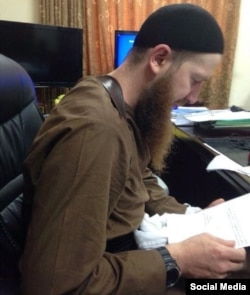Although there was a flurry of media attention in October and November focusing on Umar al-Shishani, Islamic State's military commander in Syria, he has been conspicuously absent from the scene in recent weeks and months.
Umar’s absence from the scene is in stark contrast to his previous behavior, particularly since he pledged allegiance to the Islamic State extremist group in December 2013. Since that time, Umar appeared frequently in videos and other Islamic State propaganda.
Media interest in Umar al-Shishani reached its peak in mid-November, when the head of Russia’s Chechen Republic, Ramzan Kadyrov, caused a storm by claiming on his Instagram account that Umar Shishani -- whom he referred to as “the enemy of Islam” -- had been killed. Although Kadyrov later deleted that Instagram post, Russian and Western news outlets speculated that perhaps the Chechen leader did have information about Umar’s death.
Chechen militants in Syria responded to the reports about Umar’s death with skepticism, saying via social media that the Islamic State commander was “alive and well.”
So where is Umar al-Shishani?
Despite the assurances of Chechen militants fighting with Islamic State that Umar is alive and kicking in Syria, the ginger-bearded Georgian Kist has not been seen alive (or, for that matter, dead) for some months now. Umar has not appeared in any videos, for example. And while the Islamic State group has released two photographs of Umar since October, neither can be independently verified or even dated.
The most recent photograph of Umar that was released on Islamic State social media accounts was posted at the end of December. In it, the Syrian military commander is seated indoors at a desk, apparently doing some paperwork. He appears thinner than he has in previous photographs. However, there is no way to know when this image was taken.
On January 20, a pro-Islamic State account on Twitter shared a photograph of Umar Shishani that it claimed was new. The photograph shows Umar standing at the side of a road, with his arm around a bearded militant.
There is a problem with this image, though. It is not a new photograph of Umar.
Umar appears with this same militant in the same location -- and wearing the same clothes -- in a second photograph, taken in February 2014. What appears to be the same black car appears in both images. In this second photograph, a second bearded militant appears, standing to the left of Umar. The photograph shared by the Islamic State account must have been taken within minutes or even seconds of this second photograph.
Is Umar dead? Or in hiding?
In the absence of any evidence showing his whereabouts, it is of course impossible to know whether Umar al-Shishani is alive or dead.
However, there are some clues that could point to one possible answer for Umar’s recent elusiveness: that he is alive but is being very careful to keep his whereabouts a secret.
In November, Salakhuddin al-Shishani, the ethnic Chechen leader of the Aleppo-based Jaish al-Muhajireen wal-Ansar (JMA) faction, reported that he had paid a visit to Raqqa, the Islamic State group’s de facto capital, to propose a truce to IS leaders on behalf of a number of Islamist factions, including Jabhat al-Nusra and Ahrar as-Sham.
While the accounts of Salakhuddin’s visit to Raqqa did not give any indication of whom exactly he met, there are two major clues that Umar al-Shishani was involved. The first clue is that Jabhat al-Nusra and Ahrar as-Sham chose a Russian-speaking Chechen from the Pankisi Gorge as their emissary. It is reasonable to surmise that Salakhuddin was considered the best person to reason with Umar. The second clue is that detailed accounts of Salakhuddin’s visit were presented on social media by a group of Chechens who are close to Umar al-Shishani.
The fact that Umar’s name was not mentioned in any account of Salakhuddin’s visit could also point to the fact that the IS military commander is insisting on keeping his location a secret.
Another recent development that suggests Umar could be deliberately concealing his whereabouts is the emergence of a video showing two Russian-speaking men giving what appear to be forced confessions of being Russian agents.
That video, which was shared by IS earlier this month, includes footage of the two “agents” telling an unseen interrogator that they were hired by the Russian Federal Security Service (FSB) to spy on Islamic State. Significantly, parts of the men’s “confessions” -- where the men give the name of an Islamic State leader whose location they said they were hired to disclose to the FSB -- are blanked out in the original Russian. While the full story is not known, an investigation of social media and other sources suggests that the two “agents” appear to be men who radicalized and joined the IS group.
The executions of the two men and the fact that IS made and published a video in Russian about their belief that “enemies” had sent “spies and agents to plot against IS” indicates that IS -- or one or more of its Russian-speaking leaders -- is extremely concerned about foreign agents infiltrating its ranks and finding out his or their locations. While there is no concrete evidence to prove that Umar Shishani is the Islamic State leader with such concerns, this seems a hypothesis worth considering in the light of other information about Umar’s mysterious absence from Islamic State propaganda.
-- Joanna Paraszczuk

